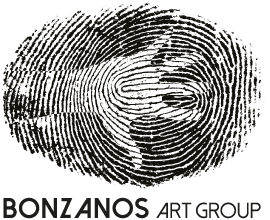Text by Tiziana Conti
Text by Tiziana Conti
The boundaries of painting have become uncertain; the consistency of the pictorial language has become less homogeneous, less compact. The work has taken on an identity with blurred outlines, it has acquired a problematic dimension that has changed its structure to the point of transforming it into a «text».
The dematerialization of the pictorial language implies the trespassing into other territories so that the radical distinctions between the areas pertaining to the individual visual arts disappear and the importance of decoding and deconstruction is accentuated.
The disappearance of openings in the texture of the painting reveals large areas of instability and inconstancy that allow us to interpret the work as FACT, renouncing pure enunciation, to privilege the hermeneutic dimension.
Stefano Bonzano’s research is located in this border area of painting, full of tensions and singular effects. He borders on the territory of architecture; he can clearly see this in the analytical intentions, in the rigorous planning, in the attention and control of the compositional structure.
But the pictorial sense is innate in him that allows him to freely fluctuate between real space and imagination, between the formal and the procedural level, letting the idea of the painting emerge as a THRESHOLD, an obligatory gateway to a world of symbolic referents.
Architecture then becomes a real way of life, the place of a utopia centred on the role of man and on some existential paradoxes: a fruitful dialogue with painting is born, which fecundates and makes changing existential configurations germinate.
Bonzano feels the suggestion of classical art and can be seen in the layout of the works, in the rhythms, in the use of the actual quotation from artists of the past, the translation of fragments of works relocated to a different semantic field.
Paradoxically, however, the classic element also becomes a mirror image of the ambiguities of reality: isolation, loneliness, emptying of action and gesture. Architecture becomes a manifestation of the spirit: the place of OBSESSIONS, disillusions, shattered memories, where the conflict between the individual and what is consummated.
The space takes on a theatrical structure, highly dramatic due to the stiffening of time and the absence of action. The only presence is that of SHADOW, a phantasmatic, disconcerting projection in an unknowable universe.
In this way Bonzano constructs an imaginative counter-architecture, full of symbolic values, in which DETAIL is the central element.
In fact, each work is designed and built around a detail that is elaborated and contextualized within a strategic path. The artist erects high, labyrinthine walls, builds rooms, claustrophobic cells that in regularity reveal the singularity of the individual.
They have profound implications, recalling, as Peter Halley clearly states, the isolated terms of the industrial structure: condominiums, hospital beds, school desks. They are parallelepipeds, cubes, which take on the identity of a prison: geometry as segregation.
Between the walls, in the cells, Bonzano disperses the individual, whose existence is reduced to a thin trace, an artefact removed from the human dimension.
It projects a flickering, elongated shadow, which dries up into an imprint, made concrete by the artist through short, thin nails, arranged with apparent randomness.
The contrast between the proportions underlines the powerlessness of the action: Kafkaesque man tries to move, to get out of fixity, but his gesture is always and in any case frustrated. This is demonstrated by the long lines of individuals, whose path crashes against an obstacle, indicating the identity between life and the vicious circle. Every link is annulled, sucked into the circularity of a movement with no outlets. The particular mix between man and architecture determines a dry, parched, estranging «landscape», which communicates an acute sense of vertigo.
It is inevitable to think of Giacometti’s man, who tries to get out of the prison of the self, to free his multiplicity and transforms himself into a lattice, a net, a knotty thread. In the most recent works, the atmosphere has become even more rarefied and the chromatic surprises have disappeared.
The red – sanguine, vital, overwhelmingly scenographic – with which Bonzano emphasized in the previous works the possibility of the gesture has given way to greys that accentuate the loss of a harmonious and balancing center: the process of chromatic simplification corresponds to the existential catatonic.
On the other hand, the importance of the support on which the canvas rests has been accentuated, itself «opera», perfectly blended with the canvas: always different, but always with a reticular structure, with tight and impenetrable meshes, which reveal the deep tension between closure and anxiety of open spaces.
Beyond the THRESHOLD unexplored territories open up, threatening yet tempting, which do not allow certainties, but rather suppositions and conjectures.
The only possible reality in life and in art.
